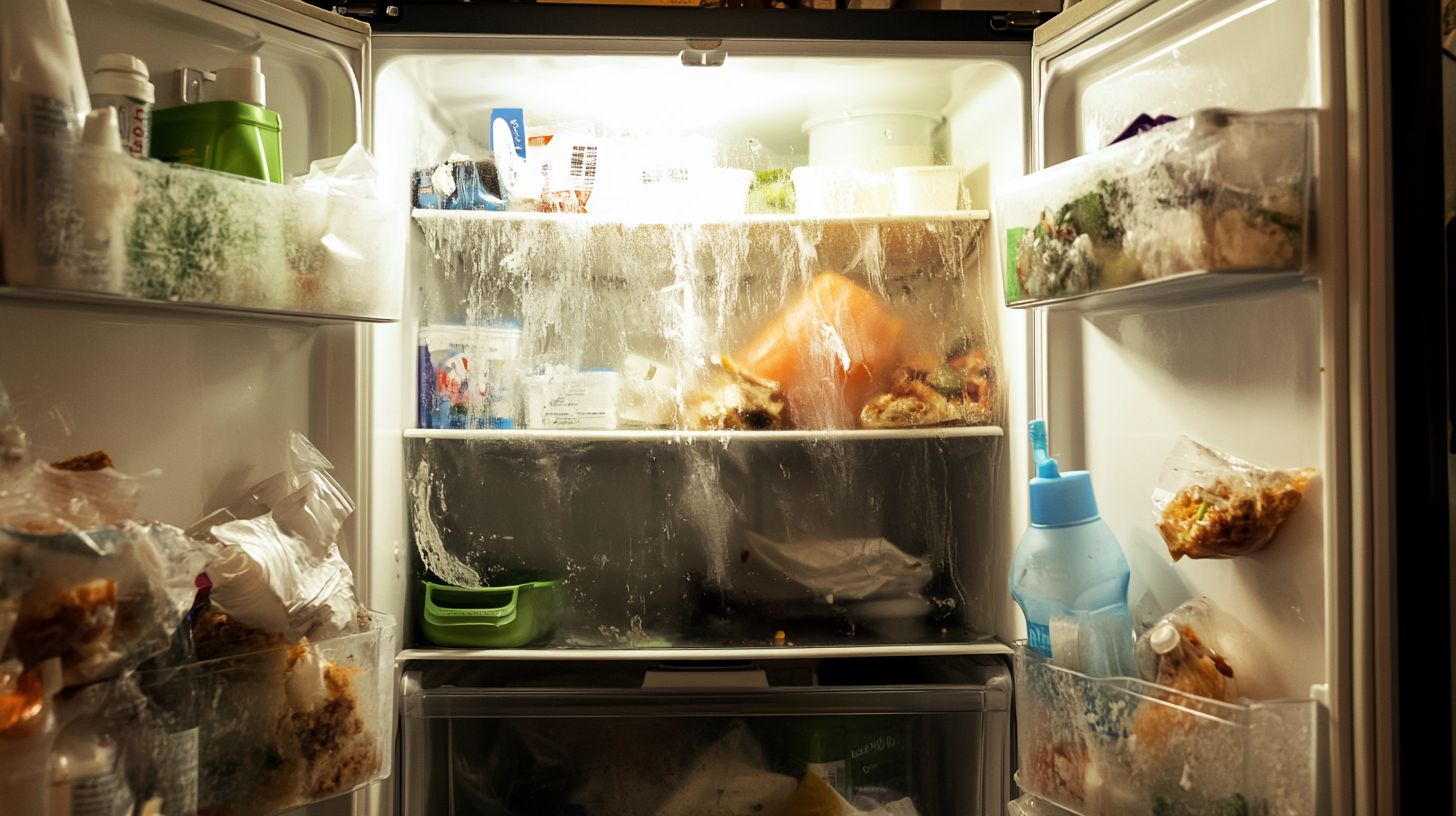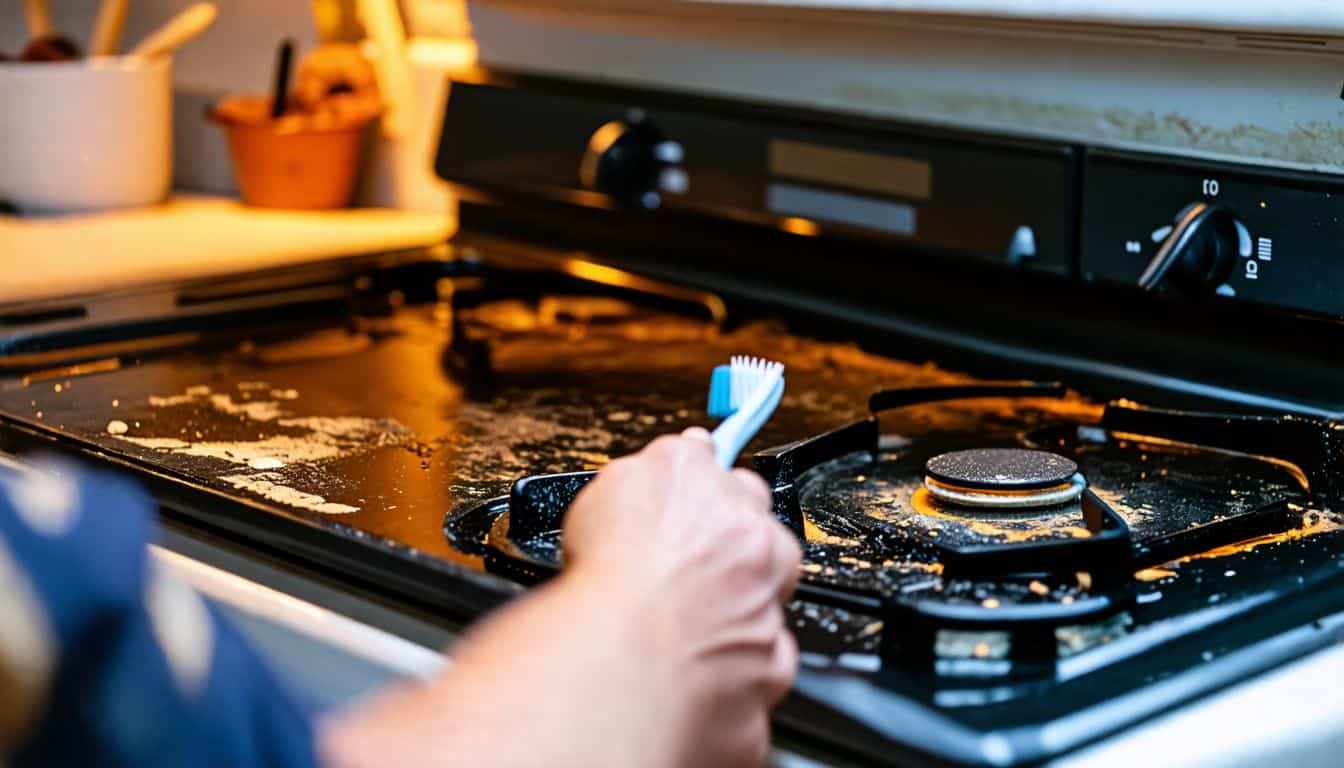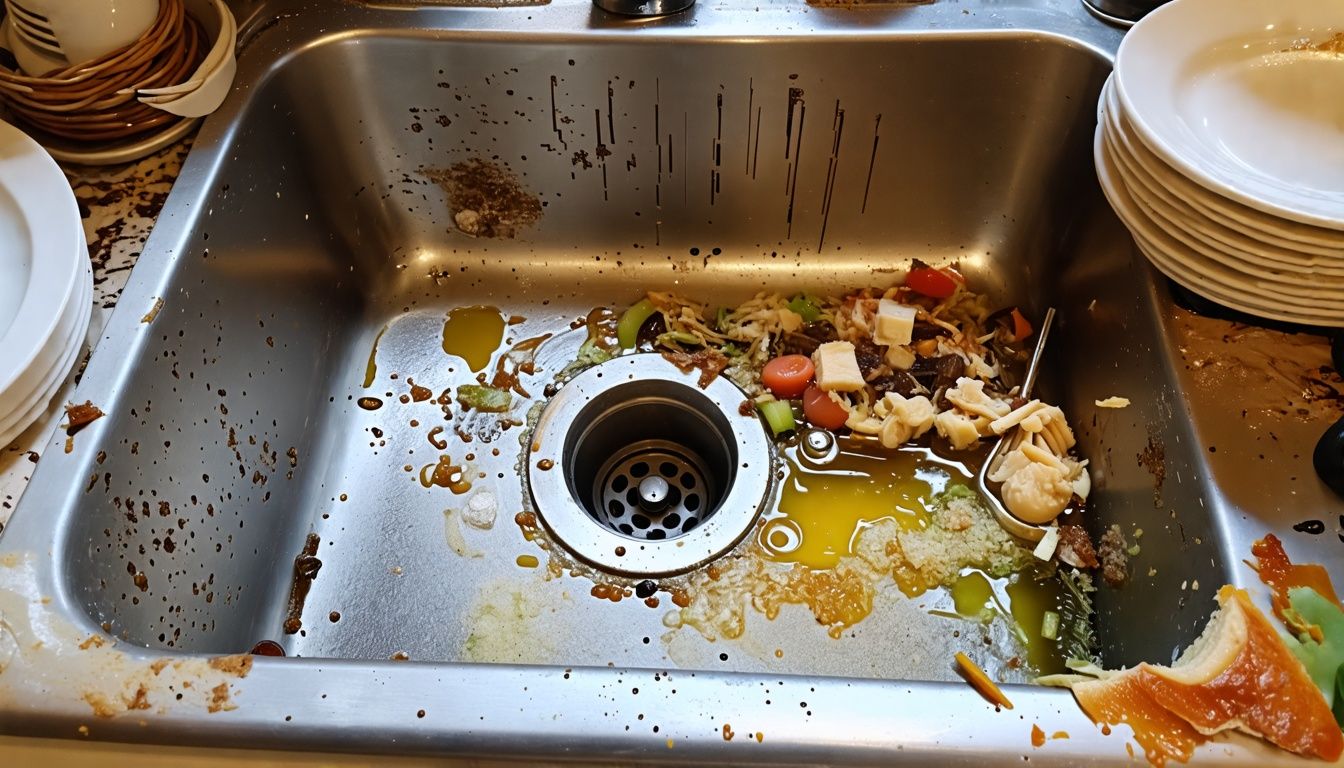Keeping a kitchen clean feels like a never-ending job. Every day, it seems there’s always something needing a wipe or scrub—counters, dishes, the floor. But even the most diligent cleaners might overlook some spots.
Not everything that needs cleaning is right in front of us. Some places hide crumbs, bacteria, and germs well.
One fact stands out: the fridge door holds more bacteria than many dare to think, often even more than a toilet seat because of its warmth allowing food and milk to spoil. This article will shine light on those forgotten areas—from under appliances to sink drains—and give practical tips for tackling them with tools like baking soda, all-purpose cleaner, and vinegar. Nothing better than a house cleaning!
Ready to make your kitchen sparkle? Keep reading!

Key Takeaways
- Fridge seals and under crisper drawers can hide crumbs and spills, requiring warm, soapy water or a baking soda mix for effective cleaning.
- Cleaning behind kitchen appliances like refrigerators and stoves is essential to avoid dust accumulation and pest attraction.
- Cabinet shelves often go unnoticed but should be emptied and wiped down with a mild detergent solution twice a year to prevent dirt build-up.
- Sink drains and garbage disposals harbor bacteria and odors; treating them with baking soda, vinegar, or bleach helps maintain cleanliness.
- Light fixtures, the backsplash behind the stove, and trash can lids are common overlooked spots that need regular cleaning to keep the kitchen sanitary.
Overlooked Areas to Clean in the Kitchen

Everyone knows to wipe down counters and mop floors in their kitchen. Yet, many forget spots like inside the refrigerator or under big machines that collect crumbs and spills.
Inside the Fridge and Freezer

Cleaning the inside of your fridge and freezer often gets overlooked. You should start by removing all food items. Next, take out shelves, drawers, and racks to soak them in warm soapy water.
For tougher stains, use a mixture of hot water and baking soda. This solution works wonders for wiping down the interior without leaving any harsh chemical residues behind. Don’t forget about the fridge seal — using warm, soapy water or a baking soda mix will get rid of grime build-up effectively.
Vacuuming refrigerator coils is crucial for maintaining its efficiency but is frequently forgotten. Pulling the unit away from the wall to access these coils might seem like a hassle but doing this at least twice a year can save on energy costs by improving performance.
Underneath crisper drawers tend to trap crumbs and spills; wipe this area with a wet cloth after washing drawers. Before you restock your groceries, make sure to clean both inside and outside the refrigerator door to keep bacteria and germs at bay.
Shelves of cabinets deserve attention too as they accumulate dust and debris over time.
Cabinet Shelves

Cabinet shelves often become the final resting place for food particles and small appliance manuals that we seldom utilize. This area can sometimes escape the notice of householders and parents during regular kitchen cleaning.
In dealing with these shelves, start by completely emptying them. This action unravels all hidden dirt and crumbs. Use a handheld vacuum to promptly eliminate loose debris from each shelf.
Following the vacuuming, pick a cloth dipped in warm, soapy water. Clean every surface in the cabinet, focusing on sticky spots or areas with spillage.
Once all surfaces are clean, ensure to dry the shelves with a gentle towel prior to returning your items. Strategically place frequently used tools and utensils for easy reach, possibly considering storage options like baskets for improved organization.
This strategy maintains tidiness in cabinets and facilitates locating necessities without making a mess again. For those who prefer not to find aged ketchup packets or overlooked spices during their succeeding thorough clean, sticking to this routine helps avoid the recurrence of such unexpected finds.
Sink Drains and Garbage Disposal

Moving from cleaning cabinet shelves, house owners and parents should also pay close attention to sink drains and garbage disposals in their kitchens. These areas can harbor bacteria and unpleasant smells if not cleaned regularly.
For the sink drain, a simple cleanup method involves pouring ½ cup of bicarbonate of soda followed by ½ cup of white vinegar down the drain. After letting this mixture sit for a few minutes, flush it out with boiling water to clear away any buildup.
This process helps keep your kitchen smelling fresh and prevents clogs.
As for the garbage disposal, start by soaking its gasket in a mixture of vinegar and hot water. Then give it a good scrub to remove accumulated grime and food particles. The flange area of the garbage disposal requires monthly attention as well; clean it using a solution made from hot water mixed with bleach.
This routine ensures that your disposal unit stays germ-free and operates efficiently without emitting foul odors into your kitchen space.
Stovetop Crevices

Proceeding with the tasks of maintaining sink drains and waste disposers, it becomes essential to shift the focus on stove top cracks. These confined areas accumulate oil and parts of food, turning them into a prime location for dirt accumulation.
Professionals encourage the purchase of a crumb catcher for facilitating the cleaning process. This straightforward remedy amasses food waste before it falls into difficult to access spots.
For surfaces made of stainless steel, the suggestion of Katina Mountanos is to buff them using ordinary olive oil with a microfiber cloth. This strategy cleans as well as provides luster to the stove top without the need for the harsh chemicals present in conventional cleaning agents.
The usage of a mild degreasing agent is effective for persistent stains, making sure the kitchen stays clean and visually attractive.
Under Major Appliances

Under major appliances, like refrigerators and ovens, food particles and debris hide out of sight. They need cleaning now and then. Homeowners can vacuum or use a wipe to clean these areas effectively.
Sometimes, the oven has a bottom drawer that comes off easily for better access.
Using a vacuum grabs loose particles while mopping ensures any sticky spots go away. This method prevents bugs from making their home under these appliances. House owners find this task important for keeping their kitchens clean and safe.
Hidden Spots You Might Miss While Cleaning
Even the most thorough cleaners can overlook certain areas in their kitchens. Hidden spots gather dust and grime, but often escape notice during regular cleaning routines. Behind large devices, like refrigerators or washing machines, dirt and food particles find a perfect hiding spot.
The lid of your garbage container also harbors germs that can spread throughout your kitchen if not regularly cleaned. Another area easily missed is the wall area behind your cooking stove, where splashes and cooking residue accumulate over time.
For tackling these hidden spots effectively, experts recommend moving large appliances periodically to sweep and mop the floor beneath them. Using disinfectant cloths on trash bin lids ensures they remain germ-free.
A mixture of cleaning liquids can work wonders on the backsplash behind stoves, cutting through grease that traps odors and bacteria. Simple tools like scrub brushes or old toothbrushes reach into tight spaces around appliances to remove buildup that’s out of sight.
Behind Kitchen Appliances

Dust and pests locate a sanctuary in the area behind kitchen apparatuses like fridges and stoves. Homeowners frequently neglect these spaces during deep house cleaning, leading to accrued dust and the lure of pests.
Shifting appliances to clean these areas is essential for a comprehensive kitchen tidying routine. It hinders the accumulation of dirt and maintains the healthiness of the kitchen milieu.
To efficiently handle these concealed spaces, utilizing a duster or vacuum can discard loose particles primarily. Subsequently, applying a gentle cleansing agent or degreaser aids in eliminating obstinate filth.
Periodic checks and cleaning behind refrigerators ascertain that your kitchen remains fresh and void of pests that are attracted to confined grease and food residues. This strategy contributes to the comprehensive cleanliness and also boosts the durability of your appliances by maintaining their surroundings neat.
Trash Can Lid
The trash can lid is a spot many overlook in their kitchen cleaning routine. Yet, it can collect bacteria and unpleasant smells if not cleaned regularly. House owners should tackle this by using a simple mix of vinegar, dish soap, and water.
This solution works well to remove grime and disinfect the surface. Cleaning it regularly ensures that the kitchen stays more sanitary.
Parents especially need to keep this area clean for a healthier home environment. They find that regular cleaning with disinfectant wipes or the mentioned solution helps maintain freshness in the kitchen.
It’s easy to forget about small areas like trash can lids, but they play a big part in keeping your space clean and odor-free.
The Backsplash Behind the Stovetop
Cleaning the backsplash behind the stovetop becomes crucial for homeowners and parents aiming to maintain a spotless kitchen. Grease and food splatters often collect on this surface due to its proximity to the cooking area.
These residues can create a sticky film that traps dirt and bacteria, making it essential to clean regularly. Zep Commercial All-Around Oxy Cleaner and Degreaser proves effective for tackling these tough stains.
Homeowners find this cleaning solution powerful in removing grease without leaving harmful residue behind.
Applying this cleaner with a soft cloth or sponge works best. This method helps avoid damage to the backsplash material while ensuring a thorough cleanse. Regular maintenance of the backsplash prevents buildup, keeping kitchens sanitary and visually appealing.
Incorporating this task into routine cleaning schedules ensures that even hidden spots contribute to the overall cleanliness of homes where families gather and share meals.
Practical Tips for Cleaning Forgotten Kitchen Spots

House owners and parents often miss some kitchen spots during routine cleaning. Addressing these areas can lead to a more organized and clean kitchen space.
- Utilize Zep Commercial Quick Clean Disinfectant for daily wipes of surfaces.
- For the fridge and freezer interiors, take everything out monthly. Then, use Zep Commercial All-Around Oxy Cleaner on stains.
- Empty cabinet shelves twice a year, wiping them down with a mild detergent solution.
- Clear and scrub sink drains using baking soda and vinegar mixture once a month to remove buildup.
- Use an old toothbrush or a small brush to clean stovetop crevices after spills.
- Slide out major appliances semi-annually to sweep and mop the area beneath them.
- Pull kitchen devices forward to wipe the walls and counters behind them every few months.
- Wash the trash can lid with soapy water every week to avoid unpleasant smells.
- Spray the backsplash behind your stove with degreaser to tackle grease splatters once a week.
- Check light fixtures monthly for dust and dead insects, cleaning them with a damp cloth.
- Once every three months, run an empty dishwasher cycle with hot water and vinegar to sanitize it.
- Disassemble small appliances like kettles and microwaves quarterly for thorough cleaning.
Following these tips ensures that even the most easily forgotten places in your kitchen stay as clean as the rest of your home.
Conclusion

Keeping your kitchen clean means paying attention to the places you might often forget. The spaces under and behind appliances hold unseen messes. Sink drains and garbage disposals need regular care to prevent bad smells. Book cleaning services online now with My Cleaning Angel. Get a quote right now and have your kitchen and the rest of your house shining!
Cabinet shelves can collect dust and spills over time. Even the spots like range hoods, where grease gathers, require a good scrubbing now and then. By focusing on these overlooked areas, you ensure a healthier cooking space for everyone at home.
FAQs
1. What are some often overlooked areas to clean in my kitchen?
Some of the most forgotten places include the range hood and filters, light fixtures, ceiling fans, and even your dishwasher.
2. Why is it important to clean the range hood and its filters?
The range hood plays a crucial role in trapping grease during cooking. If not cleaned regularly, it can become less effective over time.
3. How do I go about cleaning my dishwasher effectively?
Cleaning your dishwasher involves removing food particles trapped inside, running a cycle with vinegar or a special cleaner for dishwashers.
4. Are there any tips for maintaining cleanliness in these forgotten areas of my kitchen?
Yes! Regular checks on sinks, light fixtures and ceiling fans could prevent build-up of dirt or grease that makes cleaning more difficult later on.






